Software development is a complex process. And the more functionality the product requires, the more complicated it is to handle all operations and ensure project quality. It’s up to project managers (PMs) to make sure everyone on the team is on the same page and all development steps are completed on time.
Agile methodologies are a popular choice for managing software development projects. They allow teams to be flexible and adaptable, efficiently responding to changes and challenges as they arise. However, this approach isn’t bulletproof and requires PMs to include risk management practices in their routine.
In this article, we overview what risks your PMs should be aware of and describe the four major stages to effectively handle project risks. We also offer Apriorit’s tips on how to improve your Agile risk management.
Contents:
What risks to expect when using Agile methodologies
When choosing the right software development methodology, PMs must consider project specifics to make sure their choice will helps them plan processes, manage work, and facilitate team collaboration. Since each methodology offers its unique principles, tools, and techniques, it’s essential to pick one that suits your specific project.
Agile is one of the most popular approaches to project management and includes various project methodologies including Scrum and Kanban. The Agile approach itself is focused on breaking the project into phases, also called iterations. Agile emphasizes continuous collaboration and improvement, where development teams follow a cycle of planning, executing, and evaluating.
As a result, Agile methodologies help software development teams accelerate a product’s time to market, accurately plan delivery, and minimize risks.
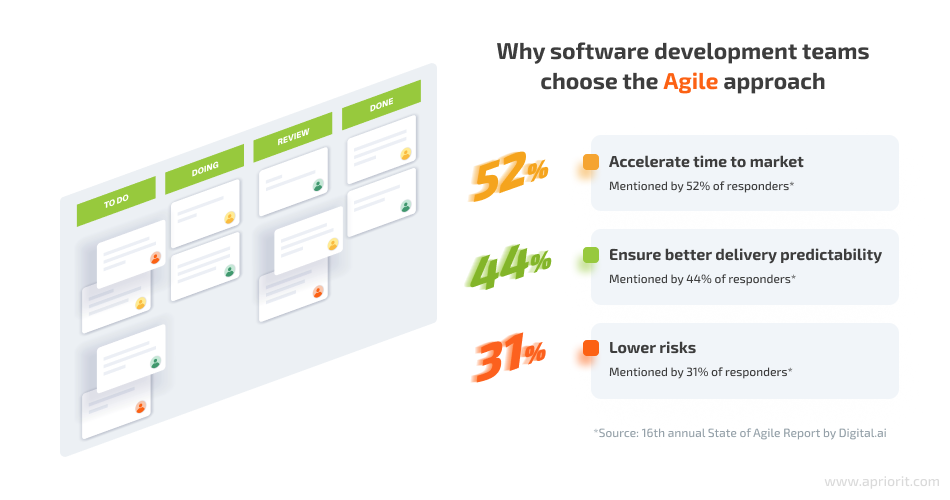
Although the Agile approach provides unique possibilities and opportunities to improve the development process, it doesn’t save your team from all challenges and uncertainties, also known as project management risks.
Such risks can vary depending on your project specifics, but generally you can divide them into the following four categories:
- Budget risks. These include the need to implement an extra feature, adjust planned functionality, or fix unpredicted issues that often appear during software development. Going over budget is a potential risk that project managers need to be ready to deal with.
- Scope creep. This risk refers to unplanned project expansion due to adding features not planned during the initial stages or due to other changes made to the project scope without any control procedure like proper estimation or prioritization. This risk will cause deadlines to be pushed and will delay product delivery.
- Time delays. The reasons for missed deadlines for project milestones can vary and include inaccurate planning, improper management, and lack of skills and experience.
- Miscommunication. All parties involved in the project should clearly understand the product’s business goals, target audience, required functionality, etc. Otherwise, developers might misunderstand task priorities, project results may not match stakeholders’ expectations, and miscommunication can cause delays in decision-making.
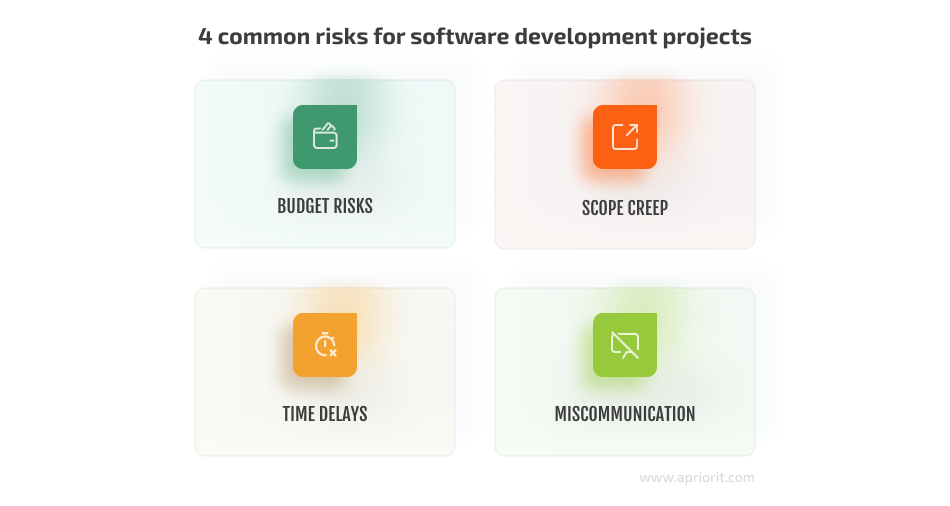
To maximize the benefits of the Agile approach, project managers have to be aware of what risks to expect and plan relevant activities to prevent or mitigate them. We discuss how to ensure proper risk management in Agile software development in the next section.
Looking to optimize project delivery?
Leverage our project management expertise to streamline workflows, reduce risks, and meet deadlines with precision.
4 stages of managing risks in Agile: tips & tricks
Ways to ensure risk management in Agile can vary significantly depending on the chosen methodology and project specifics. However, the four main stages of managing project risks that are common for the majority of IT projects are:
- Identification
- Analysis
- Mitigation
- Monitoring

Let’s see how to adapt these risk management stages to the specifics of the Agile and hybrid methodologies and explore helpful tips and tricks based on Apriorit’s 20+ years of practice.
1. Identify the risks
The first step in dealing with project risks is to identify them as early as possible. It’s crucial to conduct a risk assessment at the project outset so that stakeholders, managers, and the development team will know what potential issues to expect in the future and will be ready to face them.
During this step, it’s important to thoroughly analyze the project from both a technical and business perspective. Thus, your team will be more likely to effectively detect and process the maximum number of potential risks.
Let’s discuss three ways to improve risk identification:
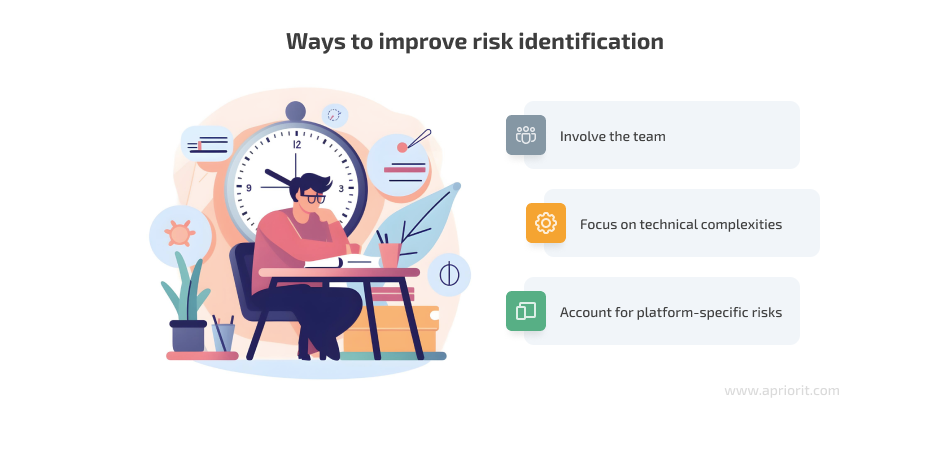
Involve the team
Agile development is all about collaboration, and the same is true when it comes to managing project risks. By involving the whole team in the risk identification process and encouraging all team members to share their concerns and ideas, a project manager can identify unobvious risks.
This will not only help to identify new risks but will also build a sense of ownership and responsibility among the team.
At Apriorit, we actively use a risk register, which we’ll discuss in detail in the second stage. We made reviewing the risk register a regular activity and introduced relevant activities to improve established Agile practices. Here are a few examples of activities we conduct during grooming sessions:
- Discussing and determining the possible impact of planned features
- Discussing technical debt that might occur when working on new features
- Proactively addressing any risks related to the possible impact of user stories on already implemented functionality
Making user stories too large is a common risk in software development, as large user stories are likely to contain a significant amount of uncertainty.
Pro tip: During planning meetings, the PM should discuss the size of user stories with the team, define the maximum story size, and specify it in story points. Then, if a story estimate is larger than the maximum agreed size, the PM together with the team should split the story into smaller ones or create an additional spike story that will result in a better understanding of the original user story.
Read also
How to Choose the Right Software Development Methodology for Your Project
Choosing the right development methodology is key to your project’s success. Explore the pros and cons of Agile, Waterfall, and other methodologies to determine which approach aligns best with your goals and resources.

Focus on technical complexities
Developing software for desktop or mobile devices requires a deep understanding of hardware and system-level functionality. And this introduces lots of technical complexities and uncertainties that are likely to affect the estimation of project timelines and resource requirements. The most common risks that occur in such a case are underestimation of work and missed deadlines.
To identify such risks, a project manager has to make sure that the team has a clear understanding of the technical complexities involved. Then PMs can adjust planning processes and management accordingly.
Let’s explore an example of a risk that might appear related to technical complexity:
Say your team needs to implement a seemingly simple extension for an already working feature. This task requires working with a system API that isn’t well-documented but appears to be a must-implement asset. Uncertainty is introduced, as the team doesn’t have experience with exactly this asset. Your team identifies the risks of:
- Unforeseen impact or other applications of system behavior
- Underestimating the required implementation time
- Missing the deadline or even failing to complete the task
In such a case, the best decision for the project manager will be to create a spike story, especially if the team is working on a proof of concept. In Agile, a spike story is a user story that requires more information so the team can estimate how long it will take to complete. Also, a wise decision would be to research any risky assets until the team is confident in how to solve the problem.
Pro tip: If PMs notice too much uncertainty related to technical complexities of certain functionality, they should suggest revising the feature set. This approach is likely to be more efficient development-wise (compared to spending time on research) while still covering the business value of a user story.
Account for platform-specific risks
Many software types simultaneously target end users of different devices: personal computers, laptops, mobile phones, tablets, etc. That’s why product companies often require one of the following approaches:
- Create application versions for different platforms simultaneously using two or more development teams
- Create the same application for different platforms simultaneously using the cross-platform approach
- Create application versions for different platforms in a specific order
One problem is that the same feature may have several different solutions for different platforms. Thus, it’s likely to introduce platform-specific complexity and additional risks that might affect the deadlines and budget.
Say that your team has to create a new version of an existing product for a new platform or operating system. Let’s explore a few examples of risks and issues that might arise:
- A feature created for one operating system can take much more effort to develop for another operating system
- A certain operating system or platform doesn’t provide an opportunity to develop and implement a feature that will work exactly the same way as it does on another platform
- On different platforms, software may require different security levels and system permissions to function properly
As a result, a product that needs to support multiple platforms will have increased complexity and associated risks. That’s why it’s a must to carefully plan such a project in order to avoid unforeseen functionality limitations, missing deadlines, or exceeding the budget.
PMs must include platform-specific risks into the project’s risk assessment and planning stages as well as ensure that appropriate resources and testing plans are in place to minimize issues.
Pro tip: If a project involves developing the same software for different platforms, a project manager should engage a business analyst (BA) in the preparation process. A business analyst will help the team research the alignment of product functionality across different operating systems.
Read also
5 Cases When Having a Business Analyst is a Must for Your Project
Find out how business analysts can save your project time and money by setting well-defined requirements, improving communication, and suggesting competitive features. Discover the critical role they play in success.

2. Analyze the risks
Once risks are identified, project managers have to prioritize them and develop a solid mitigation plan. Risk analysis helps PMs understand the possible impact of risks, detect the most dangerous risks, and choose the most suitable mitigation strategies. The two most popular ways to do that are using a risk register and a risk matrix.
To thoroughly analyze risks, managers should consider:
- Potential impact of a failure
- Likelihood of a risk situation occurring
- Resources required to mitigate the risk
At Apriorit, we create a project risk register as the result of the risk analysis step. In Agile environments, the complexity and form of such a document can vary depending on how risky the project is.
Let’s take a look at the default form of a risk register that your managers can adjust according to the needs of a specific project.
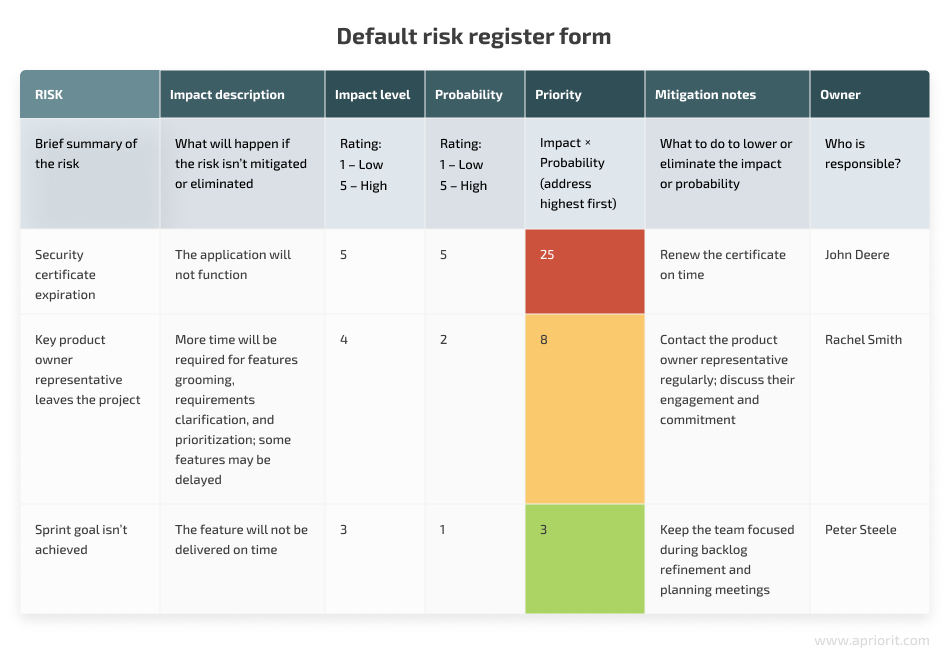
Pro tip: When analyzing risks, project managers should involve different stakeholders aside from the product owner representative and development team. For example, for some projects, it would be wise to engage representatives from senior management. This will provide your project managers with more information from different perspectives, offer a broader vision of each risk, and help to analyze risks more precisely.
3. Mitigate the risks
Once major risks are identified and assessed, project managers have to start developing a clear plan that addresses each identified risk.
Such a plan might involve changing the project scope, adding more resources, or adjusting the development approach. It will also be wise for project managers to include risk analysis results into the plan for each iteration to efficiently and timely react to risks.
For each project, Apriorit project managers use practices with proven efficiency. Here are three tips your PMs should consider to mitigate possible risks:
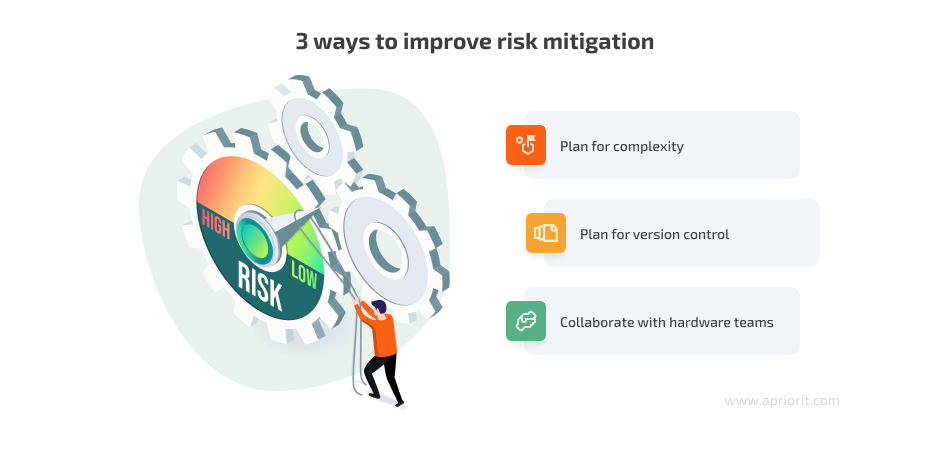
Plan for complexity
In software development, there’s always a risk of facing groups of tasks that seem much simpler than they really are. Such tasks cause significant workload adjustments and delays in project milestones.
To detect tasks that appear to be more complex than the team expects, project managers should analyze failed tasks in a given iteration and look for common patterns. Thus, they can identify tasks that are most likely to be troublesome and adjust them accordingly to mitigate the risk of delays in the future.
Let’s explore an example of complexity-related issues.
Working on user stories is often more challenging than it seems. Usually, there’s a certain threshold for the number of story points, and when a user story exceeds this threshold, it’s likely to fail or be difficult for the team to deliver.
When reviewing sprint analysis results for one of our projects, Apriorit project managers noticed that stories originally estimated as 13 story points or more had a higher percentage of spillover stories than smaller ones.
Thus, we decided that every user story that includes 13 or more story points requires additional grooming and can’t be included in a sprint as is. Here is how your PMs can address such complexity-related issues:
- Review each user story to see whether it requires additional research
- Create a proof of concept to test the idea before rushing to spend resources on a full-scale solution
- Break down the user story into smaller stories if possible (iterative development process)
Read also
How to Conduct an Efficient Competitor Analysis and What Techniques to Use
Gain a competitive advantage by mastering key competitor analysis techniques. Learn how to evaluate your competition, identify opportunities, and make data-driven decisions to improve your market positioning.

Plan for version control
Your development team may face significant risks related to version control — the practice of tracking and managing changes to software code. This practice involves using specific software that helps the development team manage changes to source code over time. When chosen thoughtfully, a version control system can help your team work fast, manage processes efficiently, reduce development time, and increase successful deployments.
But if your PMs together with the development team don’t effectively plan the version control approach beforehand, your project might suffer from delays.
To get the maximum benefits from a version control system and avoid issues, all team members should understand how to use version control effectively. Your project managers should ensure that the team agrees on best approaches for controlling the use of different software versions. For example, consider using branching and merging strategies to manage code changes and minimize conflicts.
Pro tip: In Apriorit’s practice, we tend to use the GitFlow branching model. It’s popular and reliable, allowing our team to efficiently organize the codebase, streamline the development process, and mitigate the risk of spending too much time managing branches rather than building the product.
Collaborate with hardware teams
Another type of risk your PMs should watch out for during product development is risks related to incompatibility of software and hardware components.
A proven way to mitigate or even avoid them is to ensure communication channels between the software and hardware teams as well as to include hardware requirements in the project planning and management process. A significant benefit of the Agile methodology is that it offers software development teams a certain freedom within project communication, including opportunities for close collaboration with hardware teams.
This will help your team ensure that software and hardware components work together effectively right from the start. Thus, your team can mitigate the risk of unplanned fixes and minimize delays in the development process.
4. Monitor the risks
Agile risk management processes are ongoing, so it’s vital to continually monitor risks throughout the project lifecycle. For project managers, this means:
- Regularly reviewing the risk register
- Assessing the effectiveness of mitigation strategies
- Introducing adjustments whenever necessary
- Keeping the team informed of all changes and updates to the risk management plan
The activities to include in risk monitoring significantly vary depending on a project’s specifics, but the core PM needs for the majority of projects are to:
- Monitor risks from the risk register
- Track changes in risks
- Detect new risks
- Deal with risks found during monitoring
Let’s discuss two efficient tips that will help your PMs cover the needs we discussed above:
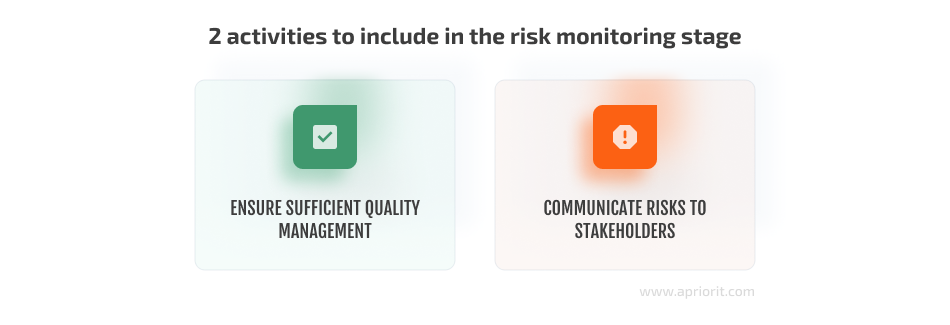
Ensure sufficient quality management
What connects quality and risk management in Agile? Creating new functionality might significantly impact your project’s stability, performance, and security. And the price of a mistake can be high.
One of the key steps to avoiding issues that might cause severe troubles for software under development is establishing a robust quality management system. To do that, your project managers should allocate sufficient time and resources for quality assurance (QA) activities including:
- Unit testing
- Integration testing
- System testing
Pro tip: Build quality management into each stage of the development process, from requirements review during the discovery stage to acceptance testing during the production stage. Also, consider using automated testing tools and techniques whenever applicable to streamline the testing process and ensure consistency.
Related project
Improving a SaaS Cybersecurity Platform with Competitive Features and Quality Maintenance
Discover how our team helped a client enhance their SaaS cybersecurity platform. We helped client’s team to deliver improved threat detection, faster performance, and more robust protection for sensitive data across the board.

Communicate risks to stakeholders
As part of effective communication, PMs need to immediately inform stakeholders of any risks found during monitoring. This helps to build trust and confidence in the project team and reduces the likelihood of surprises or misunderstandings.
Pro tip: Include discussions of risks in regular communication with stakeholders. For instance, you should keep your risk register up to date and available to all project stakeholders. To make sure that critical business decisions are made on time, establish clear rules for informing project stakeholders about newly discovered risks based on their severity and probability.
Conclusion
A lot of obstacles can arise during Agile software development: clients might introduce new requirements, or developers may face unexpected challenges when implementing new features. To predict and mitigate such issues, your project managers need to carefully manage risks.
However, risk management in Agile projects can be tricky. Effective risk management is a continuous process that requires collaboration, communication, and a willingness to adapt to changing circumstances.
At Apriorit, we have experienced project managers who know how to make Agile and risk management work together. We efficiently adjust our processes in response to risks, assessing and addressing them as soon as possible. During our work, Apriorit specialists focus on what’s best for your project, ensuring proper product quality and meeting budget and time requirements.
Make sure all your projects are expertly managed
Partner with Apriorit to ensure seamless execution of your software development projects, delivering high-quality results on time and within budget.


